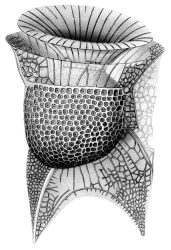Main Page
 |
DINOFLAJ3 |
 |
| Scanning electron micrograph of Charlesdowniea clathrata, an Eocene fossil dinoflagellate cyst (dinocyst) from Maryland, U.S.A. Image courtesy of Dave Goodman. | Species illustrated by Ehrenberg, 1837b as Xanthidium. Upper and lower left: "Xanthidium ramosum" (now Spiniferites ramosus); upper right: "Xanthidium tubiferum" (now Hystrichosphaeridium tubiferum); lower right: "Xanthidium bulbosum" (now Hystrichokolpoma bulbosum). |
Update: Dinoflaj3!
12/2016: Taxonomic content is now updated. These introductory pages are in the process of being revised. There is plenty of outdated information until that process is completed.
WHAT IS DINOFLAJ3?
DINOFLAJ3 is a database system containing:
1. An index of fossil dinoflagellates at generic, specific and infraspecific ranks. This information will be updated periodically, as explained below, but initial data (2008/08/01) is from Fensome and Williams (2004).
2. The classification of fossil and living dinoflagellates down to generic rank, where it is continuous with the index information. The classification will be updated periodically, but initial data is based on the classification of Fensome et al. (1993).
3. Other information and illustrations on fossil dinoflagellates as appropriate and available, including full reference information updated from the above sources and a glossary of terms.
All information is hyperlinked for convenient browsing. DINOFLAJ2 supersedes, and is a successor of, DINOFLAJ (Geological Survey of Canada Open File 3653), which was distributed as a website and CD from 1998 to 2004. Information will be updated periodically in the form of a new version of DINOFLAJ2. In order to avoid confusion, it is recommended that, in citations of this database, the version of DINOFLAJ2 always be indicated. Past versions will be archived.
This version of DINOFLAJ2 should be cited as: Fensome, R.A., MacRae, R.A. and Williams, G.L., 2008. DINOFLAJ2, Version 1. American Association of Stratigraphic Palynologists, Data Series no. 1.
DINOFLAJ2 is also available as a complete electronic document formatted in the style of the Fensome and Williams (2004) Dinoflagellate Index.
The authors wish to acknowledge the support of the American Association of Stratigraphic Palynologists, the Geological Survey of Canada, and Saint Mary's University.
WHAT ARE DINOFLAGELLATES?
Dinoflagellates are single-celled organisms that have two distinctive flagella during at least part of their life cycle and/or a special type of nucleus called a dinokaryon (Fensome et al., 1993b). They are probably best known as a principal cause of "red tides" and paralytic shellfish poisoning. Some groups produce resistant organic-walled, calcareous or (rarely) siliceous cysts that are preserved in Mesozoic and Cenozoic sediments and sedimentary rocks. These fossils are useful in helping to determine ages of rocks (e.g. in understanding petroleum systems) and in understanding past environments (e.g. global change studies).